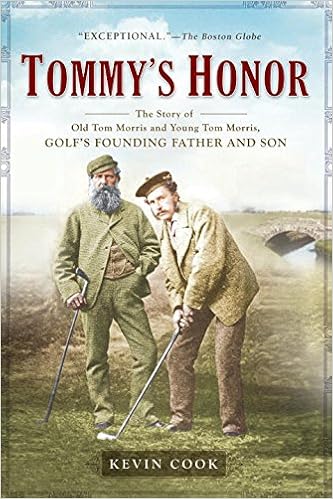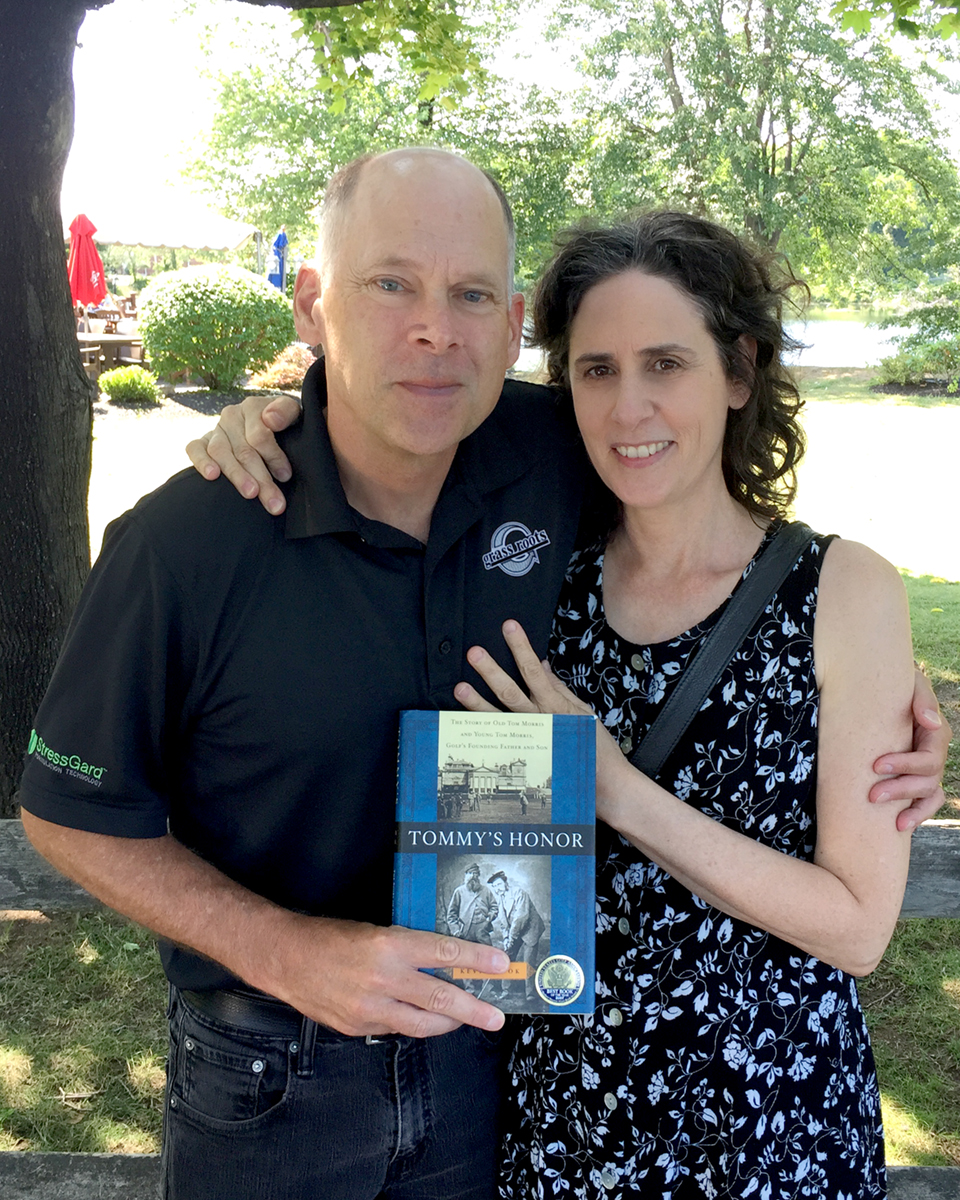Q&A With Kevin Cook, Author Of Tommy's Honor
/I resisted picking up Tommy's Honor in my usual fear of fictionalized versions of real stories and a cover that suggested it was going to be a downer. But for me it has become the best pre-Scottish golf pilgrimmage reading and one which I now crack open before heading to Scotland. (Note to self: don't judge a book by its cover.)
Any concerns about the Tommy's Honor storytelling related to golf's founding father and his decorated son are promptly eliminated when Kevin Cook takes us back to Old Tom's days in Prestwick. He captures a genuine sense of what these brave, slightly-nutty characters did to transform the idea of whapping a ball around on fescue turf and into the sport we have today. The former Golf Magazine editor does it with a perfect mix of historical accuracy, soulful storytelling and cinematic flair. Cook's 2007 book, winner of the USGA book award, is an essential and entertaining way to learn about the early days of golf and The Open. It's become an essential piece of reading prior to making a Scotland golf pilgrimage.
Cook's 2007 book, winner of the USGA book award, is an essential and entertaining way to learn about the early days of golf and The Open. It's become an essential piece of reading prior to making a Scotland golf pilgrimage.
Given the book's early focus on the first Open Championship at Prestwick and an Edinburgh Film Festival screening of the film version receiving encouraging reviews (here, here, here), the author kindly answered questions about his work.
No distributor has been finalized for the film with a screenplay by Cook and wife Pamela Marin. But since the film has just hit the festival circuit (clip's below Q&A), and we should be able to see it later this year or in early 2017.
GS: What compelled you to tackle the seemingly impossible task of re-creating the life and times of Old Tom, Young Tom and the founding of golf?
KC: My wife, Pamela Marin, took me to Scotland for my first pilgrimage in 1986. I showed up at the Old Course at dawn and was lucky enough to play with three locals, Peter, Peter and John. They blessed me gravely when I descended into the Hell Bunker and laughed when I hit a grounder and called it a worm-burner. To them that’s a “scalded cat.”
They also talked about Tommy Morris. I knew about Old Tom, but the more I learned about his son the more I was drawn to this untold family drama with a tragic love story at its heart—all revolving around the dawn of professional golf.
GS: How many years was the book in the works research-wise and what kind of interesting things happened along the way in digging through archives for this?
KC: First came 20 years of filing away bits and pieces of the story. Then I got fired as editor of Golf Magazine. Seemed like a good time to write that book! In 2005 I rented a room in St Andrews and spent a couple weeks haunting the university library. That was the first of several trips, with side trips to the Mitchell Library in Glasgow, other archives in Scotland and the library at Royal Liverpool, where Tommy won the first big pro tournament outside Scotland in 1872. I hit a few worm-burners there before the 2006 Open Championship.
Along the way I made friends. One I’ll never forget was the late David Malcolm, a St Andrean who was one of the smartest and warmest people I ever met. (His Tom Morris of St Andrews: Colossus of Golf, co-written with Peter Crabtree, is a more scholarly approach to Tom’s life.) We compared notes and shared research. Our families became close, and we even house-swapped. David and his wife, Ruth, a gifted artist, got our pad in New York while Pamela and our kids and I stayed in their home in St Andrews.
GS: Old Tom’s Prestwick years have always seemed to be a bit of a mystery, yet you get right into them early on in Tommy’s Honor. What went into the Prestwick research and does Old Tom Morris get enough credit for his role in helping create The Open?
KC: Ian Bunch, then the club secretary at Prestwick, welcomed me to the upstairs archive where I pored through records of Tom’s 14 years there, including the invitations (on robin’s-egg blue paper) summoning crack golfers to the first Open Championship in 1860. Tom organized the whole thing, working with his patron James Ogilvie Fairlie and the wealthy, sporty Earl of Eglinton. Tom hit the first tee ball—just as the wind blew his necktie up over his face, blocking his view—and came in second to his rival Willie Park.
 Kevin Cook and Pamela Marin, photo by Ken KubikGS: As a writer and historian, did you struggle at all with taking what you researched and how you made it into a narrative, even if you were perhaps fictionalizing at times? (As a reader you never come across as either uncertain in your take, nor overly presumptuous about the circumstances they faced).
Kevin Cook and Pamela Marin, photo by Ken KubikGS: As a writer and historian, did you struggle at all with taking what you researched and how you made it into a narrative, even if you were perhaps fictionalizing at times? (As a reader you never come across as either uncertain in your take, nor overly presumptuous about the circumstances they faced).
KC: One surprise was how much specific information there was to tap into. During a time of what was called “Golfomania,” newspapers in Scotland and England tried to outdo each other in covering the game. I wore out a microfiche machine or two reading shot-by-shot accounts of famous matches. It was like discovering box scores from the very first baseball games.
Tom lived until 1908. As an eager publicist for his sport and his town (and his clubmaking business) he gave loads of interviews and loved to reminisce about Tommy. Many of their contemporaries wrote memoirs and gave interview of their own. David Malcolm’s research turned up fascinating details about Margaret, Tommy’s wife, which he generously shared with me. One of the great pleasures of writing the book was connecting the dots between countless details and putting them in context.
Yes, it had to hold together as a narrative. I was lucky to have a story that’s inherently dramatic, literally life and death. But there are times when you make storytelling choices, which boil down to educated guesses. For instance, I’ve got Tommy needling Tom about his lousy putting: “You’d be a fine putter, Da, if the hole were always a yard closer.” Now, I certainly don’t claim to know that Tommy said that on the hole where I’ve got him saying it, but he did tease his father, and Tom remembered that line decades later.
GS: How did getting the book to the big screen come about?
KC: A movie producer named Jim Kreutzer picked up my book on a golf trip to St Andrews and called to ask me about it. This was in 2012. Good timing. My wife, Pamela, a journalist and author of a well-received memoir, was remaking herself as a screenwriter. It’s an utterly different kind of writing—and thinking—and she’d written a script that got attention in Hollywood. That one didn’t get made, but it proved her ability. When the time came to make a deal for Tommy’s Honor, I optioned the book with one proviso: We write the script.
GS: The film looks visually stunning, but naturally, all golfers want to know is: did they make the golf scenes realistic?
KC: Jim Farmer, the R&A’s honorary professional and a former British Club Pro champ, did a terrific job as the actors’ golf coach. He got a surprise at first. During the casting process Jack Lowden, who plays Tommy, said, “Oh yes, I’ve been a golfer for years.” Because that’s what you do as an actor—if they ask if you can ride a horse or breakdance, you say yes. Later he told Jim he’d never swung a club in his life. But Jack’s an athlete as well as a brilliant young actor, and with Jim’s help he built a swing that’s authentic to the period. One thing I loved about Jim Farmer’s work was that the swings are authentic but different. Willie Park’s swing isn’t like Tommy’s.
There’s a crowd reaction that’s totally real. The great Peter Mullan, who plays Tom, had to make a ten-foot putt on a bumpy 19th-century green. He must have missed fifteen times. Each time, director Jason Connery reset the shot and the gallery got pumped up again. At last Peter knocks it in and the crowd goes genuinely wild.
The CGI people did a remarkable job recreating the blizzard of 1875 for one key sequence. And the biggest laugh in the movie comes during a favorite scene of mine, a caddies’ tournament that’s straight from the archives.
GS: How did the trimming process go for making the book into a film?
KC: As the screenwriters Pamela and I did our own whittling, sitting side by side at the computer in early 2013. If I showed you our first draft you’d see that its structure, tone and dialogue account for about 80 percent of what wound up onscreen. Jason Connery was a joy to work with and had a bunch of good ideas that we incorporated. Jason grew up playing golf with his famous father; he’s got this story in his bones.
GS: Is there anything since the book was published that you have learned that might have changed your approach to the “characters”?
KC: I think we got it right. Tom Morris was modern pro golf’s founding father. Tommy invented a new role—he was the first touring professional. Tour pros should tip their hats to Tommy every time they tee off on Sunday.
And I think or at least hope that my work, and the script of which Pamela was the lead writer, will remind readers and moviegoers that the game’s pioneers weren’t stained-glass icons out of ancient history. They were brave, tough, star-crossed strivers living in a fascinating time.
GS: What does it mean to you that your book is now often cited as required reading before golfers make the pilgrimage to Scotland for the first time?
KC: That’s the best compliment I ever got. Tommy’s Honor began with my first pilgrimage to St Andrews. If the book and movie contribute to others’ experiences, I’ll have done my bit to honor Scotland and its people.












